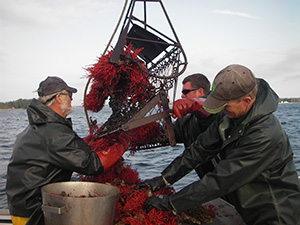2.1 Dredges as Sampling Tools
 2.2 Link to Patent Tongs as Sampling Tools
2.2 Link to Patent Tongs as Sampling Tools
The base requirement for a dredge to be used in quantitative surveys is that it can be assumed to cover a defined swept area with known capture efficiency on a consistent basis. If these requirements can be met then a simple division of the number of oysters captured by the area covered gives density (oysters per unit area).
i. The dredge is towed by a flexible line of variable length with variable scope and “hinge points” at either the winch or the passage of the towline over the stern of the vessel. An additional hinge point is the attachment of the line to the dredge. The cumulative design in tow mode functions by alternately digging and releasing, hence the action of a towline over the stern of the vessel during dredging. As such the dredge scoops but does not plane, so it does not sample representatively over the course of a tow, especially when the towpath moves over varying bottom type as would be found on an oyster reef.
ii. The dredge fills over the course of the tow to become a plow, after which it does not sample. Thus the only conditions under which a dredge can be used quantitatively are for very short tows (e.g., Powell et al. 2002 and current MD DNR swept area surveys with rejection/repeat of tows that are overflowing on retrieval).
iii. A dredge is size selective because it samples the surface more so than the underlying reef. If the Young of the Year (YOY, spat) are near the surface then the sampling is not representative. Bias in favor of live animals over shell has been noted by both Powell at al. (2002) and Mann et al. (2004).
iv. A single dredge will vary in efficiency depending on scope,
v. Oyster dredges are less than 100% efficient in retention. There are no published depletion based efficiency estimates for oyster dredges. There are for surf clam and ocean quahog dredges (NEFSC-NMFS assessments), but the latter operate in uniform substrates and do not sample in an oscillatory manner when towed - they slide on wide runners and exhume the target species with hydraulic jets.
vi. A strong asset of dredges is that they can cover a considerable area within a single tow, and thus integrate over that area. This is in stark contrast to the areal sampling problem presented by tongs (see Survey Design).

